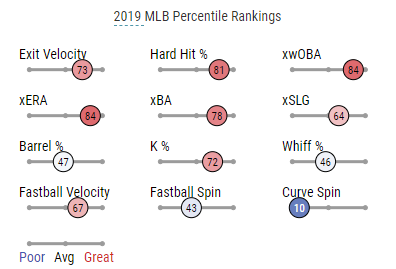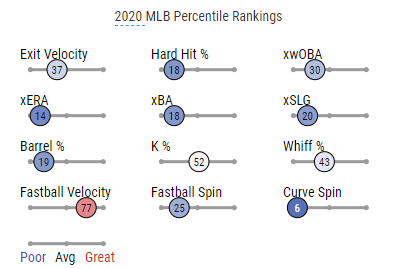Examining Chris Paddack’s Puzzling Performance
- Ryan Waldis

- Aug 15, 2020
- 5 min read

By the time Chris Paddack took the mound at Dodger Stadium Thursday evening, his team had already gifted him a two-run lead. Tommy Pham and Eric Hosmer went back-to-back in the top of the first inning and Paddack, coming off of an unimpressive start against Arizona his last time out, aimed to keep the momentum going for the Padres against an elite Dodgers squad. With San Diego taking two of the first three games of the four-game series, a win would pull the Padres even with Los Angeles in the standings.
Instead, the Padres ace hit Mookie Betts with his second pitch of the game, setting the tone for what would be a rough outing. Corey Seager, returning after suffering a lower back injury six days prior, promptly hit a two-run shot to tie the game up. Paddack allowed A.J. Pollock to go deep as well and walked back to the visitor’s dugout with his team suddenly down 3-2. The sophomore would only last two more frames before manager Jayce Tingler decided to go to the bullpen with his team trailing 6-2 after three innings. Paddack’s final line: six hits, six runs (all earned), three home runs, one walk, and one strikeout.
Through five starts, Paddack has yet to truly capture the form that made him so captivating a season ago. His Statcast profile from a season ago painted a picture of a young pitcher in a good position to improve and develop in a frontline starter; a glance at his profile this season shows something completely different.
You’ll recall that the right-hander entered 2019 as the 34th-best prospect in baseball per Fangraphs behind only nine other arms. He made the Padres out of Spring Training and brought with him a tantalizing fastball, a potentially top-tier changeup, and a developing but still intriguing curveball. Aside from hitting a slight roadblock in August, he dazzled for most of the season and entered the offseason with a solid base to build upon for 2020. Through five starts in this shortened season, however, Paddack finds himself with an unsightly 4.91 ERA (5.50 FIP) as he’s struggled to find the consistency that made him so much fun to watch in 2019.
Perhaps surprisingly, Paddack’s fastball has been one of the main reasons for his severe regression. A season ago, Paddack posted a pitch value of 13.7 with his heater, which slotted him 12th in the league among pitchers who tossed at least 140 innings. In 2020, that value has plummeted to -7.6, which is the worst mark in the majors at the time of writing. Of the seven home runs he’s allowed this year (including all three on Thursday), six have come off his fastball. The velo for the pitch is actually up about half a tick (93.9 to 94.3) so far but the pitch Paddack throws 57 percent of the time has been ineffective at best.
In 2019 Paddack’s fastball dropped 12.6 inches. The average fastball at Paddack’s velocity dropped 14.6 inches a season ago, which means Paddack got two inches of additional rise (or 14 percent more rise), placing him 48th in the league among 432 arms. As Mike Petriello notes, it’s important to understand that rise in this context refers to a pitch “dropping less than expected” since every pitch drops. Through five 2020 starts, that rise advantage has vanished. Paddack’s four-seamer is dropping 14.2 inches this year; that’s one percent less rise than other fastballs around his velocity. The drop off (no pun intended) is significant—a swing of 15 percent in the wrong direction which could help to explain why Paddack’s fastball is getting hammered this season.
The spin rate of the sophomore’s fastball has also dropped off noticeably. Last season, Paddack resided in the 43rd percentile with the spin rate of his four-seamer, averaging 2,230 RPM. He currently finds himself in the 25th percentile, with his spin rate dropping 79 RPM to 2,151. The combination of these issues may be contributing to Paddack’s major issues with the command of his vaunted fastball—the pitch is finding the zone less (59 percent in 2019 compared to 55.8 percent in 2020), but even when Paddack finds the zone with his heater he seems to be having trouble locating it properly.
Take for example his plate appearance with Seager: Paddack managed to get ahead in the count 0-2, but let a third-pitch fastball catch way too much of the plate. Seager jumped on the mistake to the tune of a 405-foot blast to right-center, foreshadowing Paddack's difficult evening.
Other batters have certainly noticed Paddack’s struggles with his best pitch and have been taking advantage, as they’re swinging less and waiting for the right-hander’s command issues to flare up.


Naturally, because batters are swinging less at Paddack’s fastball (as shown in the first chart), they’re also whiffing less than they did at any point during his rookie campaign. They’re forcing Paddack to either make an adjustment or rediscover his fastball command and through five starts he hasn’t been able to do either. In 2019 Paddack’s four-seamer had an expected slash line of .212/.283/.393; those numbers have skyrocketed this season to .355/.478/.824 which is obviously far from ideal. The barrel rate for Paddack’s changeup has stayed relatively consistent while the rate for his curveball has improved, but the percentage for his fastball has shot up.

This isn’t to say that fastball command is the only issue Paddack is currently facing. While he’s started to throw a cutter this season, he’s still without a viable third pitch to mix with his four-seamer and changeup. His curveball continues to develop but it still leaves at least a little to be desired; a year ago Baseball America deemed his curve “loopy…firmly below-average…extremely hittable the few times it lands in the strike zone.” A starting pitcher (especially in their second season) with only two reliable pitches tends to walk a very thin line between dependable starter and bullpen piece, so until the curveball (or another pitch) fully develops, a Paddack blowup similar to Thursday evening’s is never really out of the question.
Paddack admitted after the loss on Thursday that he’s struggled a bit with the mental side of his game in 2020 as well. When asked about his struggles, the pitcher responded, “I want to get back to my strengths. I feel like I’m giving the hitters too much credit. Over(analyzing) scouting reports, things like that.” He’s of the belief that the issues he’s facing aren’t mechanical at all but rather mental, explaining that, “Being a starting pitcher, you have to be sharp. I just need to sharpen a few things up mentally and I think we’ll be back into the right direction.”
The Sheriff, as he’s known, just turned 24 in January so it’s not as if he’s dead in the water. The issues that Paddack is battling are obviously fixable. Tingler and the Padres will give their young starter a long leash to battle through these struggles and get back on the right track. In a shortened season, anomalies will certainly occur so perhaps this will just be a small blip on Paddack’s career radar and he’ll turn into a talented and consistent starter sooner rather than later.
There are valid reasons to be concerned about the former top prospect, certainly. With only six-plus weeks remaining in the regular season, there’s a chance that Paddack doesn’t fully complete his rise back to being one of the top 20 or so starting pitchers until 2021 rolls around, and that’s okay. His immense talent is evident and there’s still a great chance that he carves out an impressive career. It can take some young pitchers years until they put everything together and, recent struggles aside, there’s no reason to believe that Paddack can’t follow a similar trajectory.
(Photo of Chris Paddack: Getty Images)









Comments